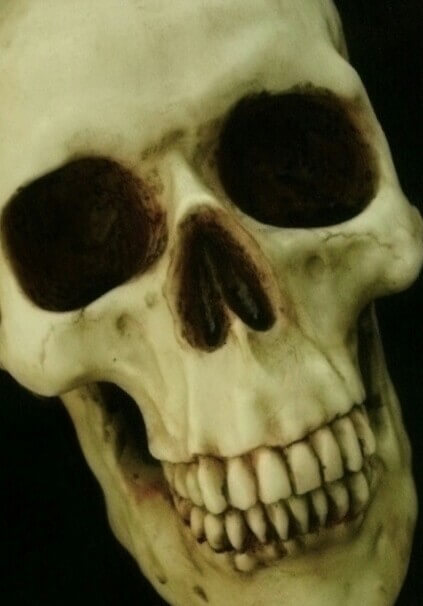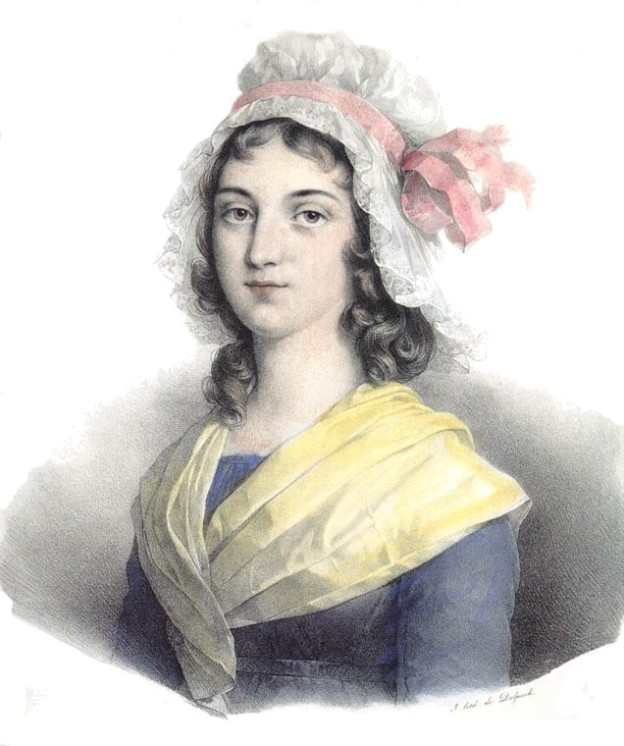On July 27, 1768, in the region of Normandy that is now referred to as Orne, Charlotte Corday was born. Corday was a 5th generation matrilinear descendant of Pierre Corneille, who is typically considered the first great seventeenth-century French dramatist. Charlotte Corday was born into this aristocratic family as Marie-Anne Charlotte de Corday d’Armont: Keeping wealth and power in the family was important, as such, her parents were cousins.
While still a young girl, Charlotte Corday’s mother and older sister passed away. Her father’s inability to cope with the death of his wife and daughter, led to his sending Corday, and her little sister, to live in a convent in Caen.
Influence from Plutarch, Rousseau and Voltaire May Have Contributed to Corday’s Demise
It is at the convent that Corday was first introduced to the writings of philosopher, writer and composer Jean-Jacques Rousseau, the writings of the Greek historian, essayist and biographer Lucius Mestrius Plutarchus (Plutarch) and one of the great Enlightenment writers of the time, François-Marie Arouet (Voltaire). These individuals were Enlightenment thinkers who wanted to end the abuses of church and state; thus, encouraging liberty, reason, tolerance, progress and fraternity.
Charlotte Corday Aligns with The Girondins
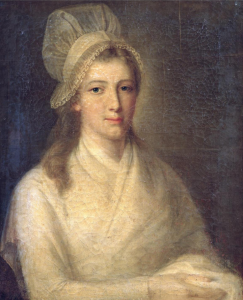
Once the French revolution became radicalized, heading toward terror and execution, Corday’s sympathies were with the Girondist groups that she met while living in Caen. Corday held their speeches in high regard; thus, she decided to become a member of their party. Corday believed that the party was the savior France needed.
The Politics of it All
The Girondins
The Gironde were concerned about the radicalization of the revolution and desired a more moderate approach be implemented.
The Montagnards
The Montagnards believed that in order for the revolution to survive civil war and invasion they had to terrorize, as well as execute those who were opposed to their way of thinking. Ultimately, the opposition to the Montagnards’ radical way of thinking and strong influences from the Gironde led to Corday’s plan to kill Jean Paul Marat.
The Revolutionary Monster – Jean Paul Marat
The Jacobin faction, of which Jean Paul Marat was affiliated, maintained a prominent role as a radicalized group throughout the French revolution. Marat was a journalist who wielded power by influencing people via his newspaper writings, some nicknamed him The Revolutionary Monster.
Corday Decides to End Marat’s Life

The Murder of Jean Paul Marat
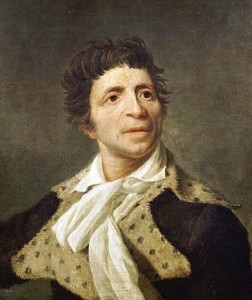
At this time, Corday resides with her cousin in Caen. She leaves her cousin with a print of Plutarch’s Parallel Lives in hand. She heads to the Hotel de Providence in Paris and rents a room. She purchases a knife that has a 6” blade. She sits down to write an explanation that outlines the reasons she is assassinating Marat.
Originally, her goal was to kill Marat as he attended a meeting of the National Convention; however, she finds that due to Marat’s failing health he does not attend these meetings anymore. Therefore, she will have to kill him in his home.
July 13, 1793 – The Day of the Murder of Marat
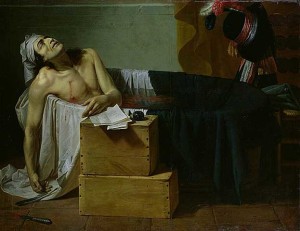
Corday returned that evening and was welcomed by Marat. Due to his debilitating skin condition, he conducted the majority of his business from his bathtub. While soaking in his tub, Marat makes note of the names Corday gives him. She quickly withdraws the recently purchased knife with the 6” blade, plunging it deep within his chest. In just one swoop Corday pierced Marat’s left ventricle, aorta and lung. As he lies bleeding in his bath, it is said that he calls out, exclaiming, “Help me, my dear friend!” It is thought this was directed to his wife. He dies shortly thereafter.
The Trial of Charlotte Corday
Corday takes full responsibility for the assassination, stating that she killed one man to save 100,000. It is believed this statement alludes to the words spoken directly before executing King Louis XVI. These words were spoken by the man referred to as the architect of the Reign of Terror during the French revolution, Maximilien Robespierre. In the end, Corday is sentenced to death by guillotine for the murder of Jean Paul Marat.
The Execution
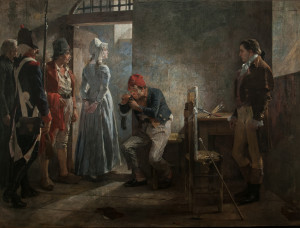
According to witnesses, the slap brought about an undeniable look of rage on Corday’s face. This has suggested that decapitated individuals may remain aware for some time following beheading. Legros did not go unpunished for these actions: He enjoyed three months in prison due to this horrendous deed.
The Autopsy of Charlotte Corday
Immediately following her execution, Jacobin leaders took her body to be autopsied. The leaders believed that Corday had a male accomplice who shared her bed; therefore, the leaders wanted to determine her virginity status. Their accusations were incorrect in that Corday was proved a virgin.
The assassination of Marat did not affect the Jacobins, nor did it limit the terror they caused. Marat was revered as a martyr. Busts of Marat were placed where religious statues and crucifixes used to rest, before being removed by the new administration.
Charlotte Corday is Frequently Referenced in Writings, Films, Music and Paintings
In 1847, 54 years following her execution, writer Alphonse de Lamartine gave Charlotte Corday the nickname ‘The Angel of Assassination.’
Jacques-Louis David paints a portrait of Marat’s last pose.
In 1860, Paul Jacques Aimé Baudry paints the scene from another angle, literally and interpretatively where Corday is considered a hero for the murder of Marat.
French, Nobel-Prize winning author Albert Camus writes in his essay, Reflections on a Guillotine, that “Charlotte Corday’s severed head blushed, it is said, under the executioner’s slap.”
A 1939 play written by Drieu La Rochelle entitled “Charlotte Corday” was performed during WWII in southern France. In the three act play, Corday is portrayed as a passionate republican who wants to eliminate Marat to prevent the revolution from collapsing into tyranny.
In the mewithoutyou band’s 2012 song Nine Stories, Charlotte Corday is referenced, the lyrics state: “I saw Charlotte Corday with the knife in her hand (It was nothing new).”
These are just a few examples as to how the tragic circumstances of Charlotte Corday’s life have become the musician’s muse and influenced the artists’ brush, the writers’ pen as well as the playwrights’ script. Chances are, we have not heard the last of Charlotte Corday, The Angel of Assassination.
Sources:
- https://en.wikipedia.org/wiki/Orne
- https://en.wikipedia.org/wiki/Charlotte_Corday
- http://www.theatrehistory.com/french/corneille001.html
- https://books.google.com/books?id=45IxAwAAQBAJ&pg=PA99&lpg=PA99&dq=seventeenth+century++marry+cousin&source=bl&ots=8kjQZsQf2r&sig=CyHCiSv_Vy6s396zhvXzPsU9WcY&hl=en&sa=X&ved=0ahUKEwjK3PDrtpPKAhXD6CYKHVt2Dp8Q6AEIKjAC#v=onepage&q=seventeenth%20century%20%20marry%20cousin&f=false
- https://en.wikipedia.org/wiki/Plutarch
- http://www.synonyms.net/synonym/matrilineal
- http://murderpedia.org/female.C/c/corday-charlotte.htm
- https://en.wikipedia.org/wiki/Jean-Jacques_Rousseau
- http://www.biography.com/people/voltaire-9520178
- https://en.wikipedia.org/wiki/Age_of_Enlightenment
- http://dwardmac.pitzer.edu/Anarchist_Archives/kropotkin/frenchrev/xxxix.html
- http://www.britannica.com/event/September-Massacres
- http://www.discoverfrance.net/France/Theatre/Corneille/corneille.shtml
- spring96.org/en/news/68097
- http://genius.com/Mewithoutyou-nine-stories-lyrics/
- http://www.bookofdaystales.com/tag/tripes-a-la-mode-de-caen/
- http://www.history.com/this-day-in-history/robespierre-overthrown-in-france
- https://en.wikipedia.org/wiki/Charlotte_Corday#/media/File:Charlotte_Corday.jpg
- https://www.goodreads.com/characters/35330-charlotte-corday
